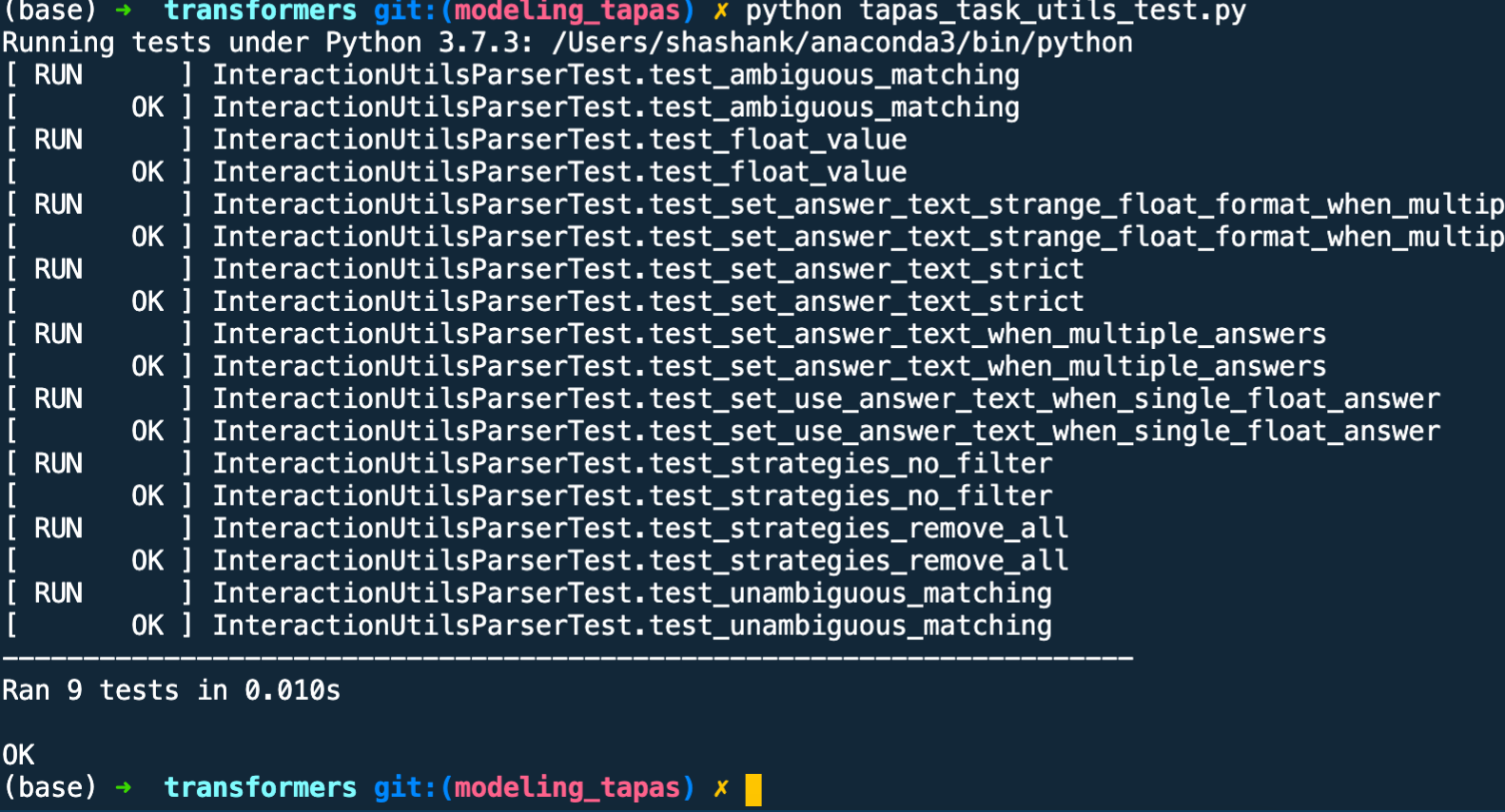Hi Niels, thanks for looking into this! I think this can be very useful to many people out there!
I didn't read your post in great detail and I am not very familiar with pytorch or the transformer library but happy to help if you have concrete questions about the TAPAS implementation.
On a higher-level, TAPAS is actually just a normal BERT model with some special embeddings to encode the table structure.
I would recommend starting to build a model that can represent a pre-trained TAPAS checkpoint. This way, you should be able to reuse most of an existing BERT implementation and you just need to add the special embeddings.

Hello,
as a summer project (and to learn a lot about both Tensorflow and PyTorch), I am working on incorporating a PyTorch implementation of the TAPAS algorithm into the Transformers library by HuggingFace. Similar to other models, the API would look something like this:
I'm submitting this issue to get feedback on my current approach (as well as a couple of questions related to the token type embeddings), and to know whether you consent on incorporating this into the Transformers library. If yes, then I would submit this issue to the Transformers repository and start working on a pull request (hopefully with the help of other people).
To implement a new model in the Transformers library, 3 things need to be defined (each in a corresponding Python script):
configuration_tapas.py)modeling_tapas.py)tokenization_tapas.py)Below, I describe my approach to each of these 3.
Configuration
As for the configuration of the base model, this seems to be a minor change of configuration_bert.py (I changed the default values of "max_position_embeddings" and "type_vocab_size"):
However, the fine-tuned model has quite a lot of additional hyperparameters (as I see in tapas_classifier_model.py). I assume that these should also be defined in the class above, correct? (this is rather a question for Transformers folks)
Model
As I am not planning to retrain any pretrained/fine-tuned model, I would define the model architecture in PyTorch in
modeling_tapas.py(which is very similar tomodeling_bert.py- at least for the base model) and then load the weights from the Tensorflow checkpoints (for now, just MASKLM base and the fine-tuned model on SQA). The Transformers library already includes a script to convert Tensorflow checkpoints into PyTorch models, with a tutorial. This script would then be adapted for TAPAS specifically and saved asconvert_tapas_original_tf_checkpoint_to_pytorch.py.Starting off with the pretrained model (MASKLM base), this is almost identical to a pretrained BERT-base, with the only difference being the additional
token_type_embeddings, as can be seen when printing out the variables of the checkpoint:It's not really clear to me what these token type embeddings are (and in what order):
token_type_embeddings_3seem to correspond with segment ids,token_type_embeddings_1and2with column and row ids, but then there are still the rank and previous answer ids. And also, what are the 2 additional token type embeddings, which do not seem to be mentioned in the paper (there are 7 token type embeddings here, but only 5 additional ids defined in the paper)? Update: appears to be "segment_ids", "column_ids", "row_ids", "prev_label_ids", "column_ranks", "inv_column_ranks" and "numeric_relations".The core idea of loading Tensorflow weights into PyTorch is to convert variable scopes to corresponding PyTorch modules with the same name (as explained in the tutorial linked above). The code below is what I adapted from the BertEmbeddings class in the modeling_bert.py file:
Alternatively, one could also let
TapasEmbeddingsinherit fromBertEmbeddingsand overwrite the changes (I see that this was done inmodeling_roberta.pyfor example). In the original BERT, the token type ids are a Tensor of shape(batch_size, sequence_length)in a single forward pass. However, since we now have several token type ids for every training example, I assume the shape is(batch_size, sequence_length, len(config.type_vocab_size))?Similarly, the forward pass of
BertModel(also defined inmodeling_bert.py) should be updated to account for the different shape of token type ids. The best way would be to define a class calledTapasModelthat inherits fromBertModeland overwrite the changes:So far, these seem to be the only differences that need to defined for the base model. However, for the fine-tuned model, the classification heads and the calculation of the loss need to be defined. To implement this in the same way as other models in the Transformers library, one could define a model
TapasForQuestionAnsweringwhich has the additional heads on top of the pretrainedTapasModel. In order to later load the weights from the Tensorflow checkpoint, the names of the PyTorch modules should have the same name. It would look something like this (also to be defined inmodeling_tapas.py):Here, the code from tapas_classifier_model.py and tapas_classifier_model_utils.py should be incorporated (and translated into PyTorch code). Looking at the code, it seems that the following heads on top of the pretrained model have to be defined:
output_weightsandoutput_bias. These are used to compute the token logits.output_weights_clsandoutput_bias_cls. These are used to compute the classification logits.output_weights_aggandoutput_bias_agg. These are used to compute the aggregation logits.column_output_weightsandcolumn_output_bias. These are used to compute the column logits. These are defined in tapas_classifier_model_utils.py.When I looked at the variables of the checkpoint of the model fine-tuned on SQA, I got this:
There is no aggregation/classification layer included here, probably since SQA does not require aggregation and classification.
Tokenizer
The tokenizer prepares the inputs to feed them into the model (i.e. turn a table and its queries into input ids, token type ids, etc.). This also includes truncating a table if it's too big. Here, the code of
tf_example_utils.pyshould be incorporated (and translated into PyTorch code). The end result should be in a script calledtokenization_tapas.py.An idea could be that the tokenizer accepts Pandas dataframes as table formats, and corresponding queries as a list of strings. This will also be far from trivial, maybe one should first convert a Pandas dataframe (together with the answer coordinates and answer text) into the intermediate Interaction format, and then convert that into PyTorch Tensors.
I know that all of this is quite challenging, but it would be awesome if it would be included in the HuggingFace repo 😄
Your feedback on all of this is greatly appreciated.